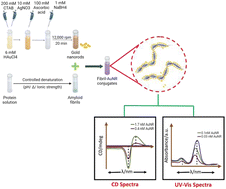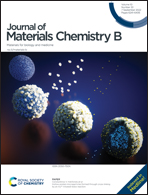Protein fibril assisted chiral assembly of gold nanorods†
Abstract
Template mediated assembly of plasmonic nanomaterials is a promising approach to induce chirality. Naturally occurring macromolecules can self-assemble to form chiral superstructures, with dimensions extending from nanometer to micrometer length scales. These structures can serve as templates for host plasmonic nanomaterials on their surface through a variety of interactions. The arrangement of nanomaterials on these structures results in a transfer of symmetry from these templates to nanomaterials, which finally generates a chiral response in circular dichroism (CD) spectroscopy. For biosensing and in vitro applications of chiral plasmonics, long-term stability of these templates will be crucial for this approach of chirality induction. Here, we have demonstrated how protein amyloid fibrils can be used as templates to generate a chiroptical response with plasmonic nanomaterials. The temperature and ionic strength of the solution were carefully altered to convert the three-dimensional protein structure into amyloid fibrils. Changes in solution conditions affected the amyloid geometry, long-term stability, and interaction with AuNRs. The modified interactions influenced the orientation of the AuNRs, which affected the intensity of the CD response. The MTT assay indicated that the chiral AuNRs exhibited considerable cell viability, making them ideal for in vivo applications.



 Please wait while we load your content...
Please wait while we load your content...